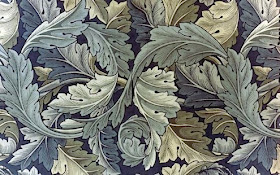The acanthus leaf has been a favorite design element for millenia. The leaf shapes appear on many Roman and Greek capitals.
Here is an acanthus leaf motif on a Corinthian capital in the Doge's Palace in Venice. The leaf shapes are more naturalistic and profuse, wrapping over the shapes and making them organic.
William Morris used the acanthus for this 1875 wallpaper design. The leaves overlap each other in sinuous curves, and are grouped by color to suggest layers of depth.
Here's an example of how the leaf was adapted for a 19th century manual on lettering. The leaf shapes have graceful S-curves that grow in close parallel curves, and then terminate in spiral finials or flare out into lobed leaf shapes. Vestigial fragments of these leaf shapes appear on the back of the US dollar bill.
Here's what the actual leaf looks like. The two main species that inspired the designers are the Acanthus spinosus and the Acanthus mollis (above), and they grow in the Mediterranean region.
The tips of the leaf are spikier than they appear in the design configuration. Most of the design adaptations have convex lobes. There's a strong single midrib with smaller side veins and secondary leaflets branching off the main midrib.
William Morris's version retains the structure of the single midrib and side-veins, but he elongates and spirals the leaf shape. The pen-and-ink version deviates from the actual acanthus by replacing the single midrib with a series of parallel rib lines, more like a plantain leaf.
------
Read more:Wikipedia: Acanthus in Ornament
"It's all in the Details -- Acanthus Leaves"







And the leaves create the arresting visage of the Bamberg Green Man -- someone I've long felt was ripe for some sort of super hero graphic novel.
ReplyDeletehttp://www.greenmanenigma.com/what.html
Thanks for mentioning that, and what a great link. I especially love the sketchbook from the 1200s. I'd like to see Marvel Comics take up your idea, a superhero that dances around the maypole, celebrates the seasons, and carries in the harvest.
ReplyDeleteIt is interesting to compare it to the way the Japanese, for example, stylize chrysanthemum almost beyond recognition.
ReplyDeleteWe may accept these visual shortcuts or artistic visions because they are easier to "read" and then eventually, they take the place of the real item in our minds. Was it here where I learned bout the book, "What We See When We Read" by Peter Mendelsund?
This may be a similar phenomenon.
There is a legend about the corinthian column I first heard while visiting the Getty Center in Malibu where plants from ancient Greece and Rome are grown:
ReplyDeleteLegend has it that a famous Greek architect was walking by a graveyard in Corinth one day in the ancient world. The grave of a young girl had been marked by a basket placed upon the soil and weighted down with a flat ceramic tile on top. No doubt it once held grave offerings to the gods of the underworld.
From beneath it sprung a native Mediterranean plant, Acanthus mollis. It was forced to grow outward and then up before it could break through the soil. When it did the flat lobed leaves surrounded the basket with a nest of green. The tall spired flowers were also distorted into graceful arches of bloom to reflect the basket’s fluted neck.
Beautiful post
ReplyDeleteI think damask when I think of acanthus leaves. I didn't realize the plant is that large with lupine like flowers.